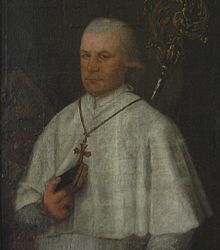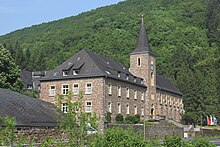Wildenberg (noble family)
|
Territory in the Holy Roman Empire |
|
|---|---|
| Wildenberg | |
| coat of arms | |

|
|
| map | |

|
|
| Wildenberg and surrounding territories around 1400 | |
| Alternative names | Wildenburg |
| Arose from | after 1202: split off from Reifferscheid |
| Today's region / s |
DE-NW
|
| Capitals / residences |
Wildenburg
|
| Incorporated into | 1335: Jülich
|
The Lords of Wildenberg in the Eifel , who first met under this name in 1235, were owners of a petty lordship until 1328 , which stretched in the southwest of what is now North Rhine-Westphalia from today's Belgian border in the west to the gates of Steinfeld Abbey in the east. Residence was the eponymous Wildenburg .
The lords of castle and lordship
Dynasts
Until around 1170 the area was in the hands of the Counts or Dukes of the Duchy of Limburg (today Belgium ). After that the practice dynasties of Reifferscheid from the rule. The Wildenberg dynasts branch off from these:
- 1234–1271 Philip II of Wildenberg (senior)
- 1270–1284 Gerhard von Wildenberg
- 1277–1310 Johann von Wildenberg
- 1311–1328 Philipp von Wildenberg (last of his line)
In addition to their heartland, the Lords of Wildenberg had remote holdings on the Rhine and Moselle , in the Hunsrück and other places in the Eifel. Philipp (senior) founded Engelport Abbey in the Hunsrück . Philipp was married to Irmgard von Braunshorn , who brought him the property in the Hunsrück. He was a highly respected witness, mediator and guarantor not only for neighbors, but also for the Duke of Limburg , the Counts of Jülich , von Sponheim and the Archbishop of Cologne , to whose permanent advisory group he was one. His son Friedrich lived in Prussia as a knight of the Teutonic Order . Johann von Wildenberg fought in the Battle of Worringen in 1288 . His son Philipp von Wildenberg is a witness when the marriage contract between Margaret of Holland and King Ludwig the Bavarian is concluded in the house of the Teutonic Order in Cologne in 1323 . When Philipp, a relative and friend of Count Wilhelm von Jülich, with whom he had also set out on a trip to Prussia , died in battle in 1328, this marked the end of this dynasty . In 1335, the daughter Katharina von Wildenberg and her husband Oyst von Elsloo left all property north of the Moselle, including the castle, to the Count of Jülich in an exchange deal . Wildenberg thus becomes a Jülich subordination .
Sublords

Meet as subordinates of Jülich:
- 1367–1398 Edmund von Engelsdorf
- 1398–1415 Dietrich von Engelsdorf
- 1416 Werner II. Von Pallandt and Simon von Birgel each half
- 1417 Charles III. von Pallandt (son of Werner II :) and Simon von Birgel each half
- 1438/39 Karsill III. from Pallandt
- 1456 Dietrich von Pallandt (son of Werner II)
- 1461/1470 Dietrich von Pallandt (1477 enfeoffment ) and his brother Johann I junior von Pallandt each half
- 1479 Dietrich von Pallandt and Johann II. Von Pallandt each half
- 1514/1524 Johann III. by Pallandt (half)
- 1530 Daem von Pallandt (receives half of his father Johann III.)
- 1533 After the death of Johann III. this half falls back into the genetic makeup and remains undivided. It should serve to care for the spiritual sons (Edmund, Reinhard and Dietrich).
- 1547 Aug. Floris I von Pallandt (great-grandson of Dietrich) Count von Culemborg ( Netherlands ) (half)
- 1547 Dec. Werner von Pallandt (son of Johann III) is enfeoffed for himself and the other male descendants of his father (half)
- 1556 enfeoffment of Floris I von Pallandt, Count of Culemborg (half)
The heirs of Floris II von Pallandt , who died childless in 1639 , cannot assert themselves in Wildenburg's possession. The entire rule is in the hands of the heirs of John III. von Pallandt, the so-called Wachendorfer line:
- 1563 June enfeoffment of Johann IV. Von Pallandt, Daem von Pallandt and children of Marsil I von Pallandt (one third each)
- 1563 Sept. Daem von Pallandt exchanged the third of Johann von Pallandt, so now has two thirds.
- 1572 Brothers Marsilius II and Werner von Pallandt (one third)
- 1572 July enfeoffment of Hartard von Pallandt (son of Daem) (two thirds)
- 1588 Werner von Pallandt (one third)
- 1601 Marsil II of Pallandt (one third)
- after 1606 inheritance disputes among his sons
- 1615 The three daughters of Hartard von Pallandt, married to Peter Ernst von Rollingen , Samson von Warsberg and Adam von Schwarzenberg , inherit two ninths each.
- 1623 Johann Franz, Florenz Ernst and Otto Hartard von Rollingen (sons of Peter Ernst) inherit two twenty-seventh parts each.
- 1625 Wolf Adolf von Eynatten (heir of Warsberg) (two ninths)
- 1643 Marsilius IV von Pallandt (son of Marsilius II) (one third)
- 1655 Marsilius IV von Pallandt acquires the two ninths of the von Eynatten family and thus owns five ninths. The two ninths from Schwarzenberg go to Rollingen, which thus owns four ninths.
- 1660 Florence Hartard von Rollingen (son of Johann Franz) and Marsilius IV. Von Pallandt each half
- 1669 With the death of Marsilius IV. Von Pallandt, this family in Wildenburg died out. The inheritance falls to Amalia Raba von Pallandt (daughter of Marsilius IV.), Johann Gottfried von Geldern zu Arcen , Hermann Dietrich von Syberg and Werner Adolf von Pallandt (sons-in-law of Marsilius IV. (Half)
- 1670 Adolf Alexander von Hatzfeld (husband of Amalia Raba von Pallandt) (half)
- 1671 Adolf Alexander von Hatzfeld and Heinrich von Rollingen (brother of Florenz Hartard) each half
- 1683 Enfeoffment to Florence Hartard von Rollingen and Adolf Alexander von Hatzfeld each half
- 1687 Hermann Dietrich von Syberg (half)
- 1700 Johann Ernst von Rollingen (son of Florenz Hartard) (half) and Anna Franziska von Syberg born. von Pallandt with her son Ferdinand Adolf (half)
- 1704 Johann Friedrich von Schaesberg (noble family) (half after acquisition from Ferdinand Adolf von Syberg)
- 1706 Johann Friedrich von Schaesberg (entire rule after acquisition of half from Johann Ernst von Rollingen)
- 1715–1802 The Abbots of Steinfeld (after buying from Schaesberg):
- Michael Kuell (1693-1732)
- Christian Steinhewer (1732–1744)
- Johann Lohelius Begasse (1744–1750)
- Gabriel Hilgers (1750–1766)
- Evermodus Claessen (1766–1784)
- Felicius Adenau (1784–1790)
- Gilbert Surges (1790-1822)
From the confusing plethora of sublords, a few are particularly noteworthy. After the administration of Wildenburg by the Margrave von Jülich himself, Edmund von Engelsdorf appeared as the first subordinate. In 1380 he was given permission to keep the sacrament of the Eucharist in the castle chapel . Daem von Pallandt lived in Wiebelskirchen (today Varize) in Lorraine and was bailiff of Sirck (today Sierck-les-bains) and Bailli von Nancy . His son Hartard was a Lorraine councilor. Edmund von Pallandt was initially a canon of Aachen , but then married and lived in the Wildenburg. After his death, his brother Reinhard moved into the castle. He was canon and chief archdeacon of Trier , later resigned and married. Built by him in 1562 in the bailey parish church with her Sprengel but lost after his death all rights and dropped back to the chapel in the parish Steinfeld down. Since Reinhard von Pallandt resigned and then married, the unilateral claim that he left "only illegitimate descendants" is incorrect. Floris I von Pallandt was knighted by Emperor Charles V himself and rose to become Count of Culemburg in the Netherlands. When he joined the Reformation , the Spanish razed his house in Brussels and erected a pillar of shame there . Marsilius IV von Pallandt donated a black marble sarcophagus in honor of St. Aldericus in the monastery church at Füssenich, on which he had all his titles noted. But in the memory of the people he lives as the witch hunter of 1628, to whom twelve women and four men fell victim. Marsilius IV, the last male lord of the Pallandt house in Wildenburg, died in 1669. The last secular owner of Wildenburg Castle and Lordship was Count Johann Friedrich von Schaesberg. His titles show his important position: Privy Councilor of the Electorate of the Palatinate , President of the Court Chamber , Bergischer Land Marshal , Knight of the Order of Hubert , Bailiff of Blankenberg and Chief Stable Master of the Electress . At a price of 40,000 Reichstalers , he sold the entire Wildenburg estate to the Steinfeld Abbey in 1715, which remained in possession until secularization . Christian Steinhewer deserves special mention among the abbots. He was Dr. the theology and rector of the University of Cologne. The French revolutionary troops marched in in 1794 under the last abbot, Gilbert Surges . The time of feudal rule is over. The main castle becomes French national property, but escapes the auction because it is given to the parish newly founded in 1803 as a church and rectory .
The domain
The heartland
The heartland with the castle included the following settlements:
- Benenberg (partially)
- Bungenberg
- Dickerscheid
- Diefenbach (partially)
- Felser (partially)
- Felserhof
- Giescheid
- Gillenberg (partially)
- Hahnenberg
- Hedges
- Heathens
- Hescheld (partially)
- Hönningen (partially)
- Hormshausen (now part of Krekel )
- Kamberg (partially)
- Kniphövel (near Kreuzberg ; desert )
- Krekel (partially)
- Kreuzberg
- Manscheid (partially)
- Marmagen (partially)
- Miescheid
- Oberpreth
- Oberreifferscheid (partially)
- Oberschömbach
- Paulushof
- Pfeifershof
- Ramscheid
- Rodenbusch
- Scheidweiler (today part of Ramscheid )
- Unterwolfert
- Elections (partially)
- Meadows (partially)
- Wildenburg
- Winters
- Zingscheid (partially)
Remote ownership
The Wildenberg dynasts had other possessions and rights of domination, but these were not passed on to the subordinates due to the barter deal of 1335.
Hunsrück, Moselle and Rhine
- Wildburg or Wildenburg near Treis
- Engelport monastery
- Braunshorn
- Dommershausen
- Eveshausen
- Külzer care
- Lying
- Löf
- Mastershausen
- Merl
- Neef
- Neuhof near Mengigart
- Rode (unidentified)
- Senheim
- Viertälergemeinde ( Bacharach , Diebach , Manubach , Steeg )
- Cell
Eifel
- Amel (now in Belgium)
- Arzfeld
- Hillesheim
- Mürringen (now in Belgium)
literature
- Manfred Konrads: The history of the Wildenburg rule in the Eifel. Handprese Weilerswist, Euskirchen 2001, ISBN 3-935221-08-8
- Ernst Wackenroder (arrangement): The art monuments of the Schleiden district. Verlag Schwann, Düsseldorf 1932, reprint Verlag Schwann-Bagel, Düsseldorf 1982, ISBN 3-590-32116-4
- Harald Herzog: castles and palaces. Rheinland-Verlag, Cologne 1989, ISBN 3-7927-1067-6
- Werner Paravicini (ed.): Courtyards and residences in the late medieval empire. Counts and Gentlemen , Part 2, Ostfildern 2012, ISBN 978-3-7995-4525-9





